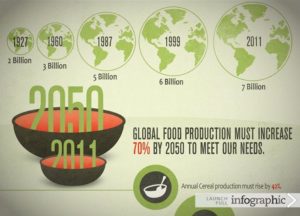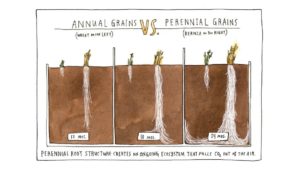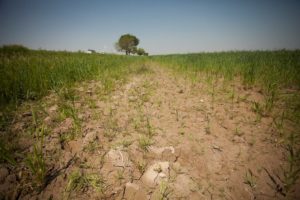Perennial Crops the Future for Global Food Production
In just 31 years, the planet’s dinner table will welcome 2 billion more hungry guests. By 2050, 9 billion people will inhabit the earth—and if overcrowding is your biggest concern, think again.
To accommodate another 2 billion people, it is estimated that global food production will need to increase by 70 percent. Yet, currently, 850 million people around the world are starving, and increasing food production doesn’t necessarily put food into these people’s bellies.

Figure 1: By the year 2050, global food production will need to increase by 70 percent in order to accommodate another 2 billion people
Much of the crops we grow end up as waste due to poor transportation and storage methods, market standards, and human negligence. Additionally, 33 percent of grain production is used to feed livestock—and this number will grow to 50 percent by 2050. To make matters worse, only a fraction of calories consumed by livestock is transferred to humans.
In order to feed our people, two things must change: meat-intensive diets must shift to plant-based diets and unused land must be cultivated for perennial crops.
The Effects of Meat-Intensive Diets
For centuries, prosperous countries, such as the United States and Canada, have enjoyed meat-intensive diets. The overconsumption of meat, eggs, and dairy, however, poses serious health concerns. For instance, high levels of animal protein in one’s body can increase the risk of death from cancer and diabetes.
Meat and dairy production are also carbon-intensive—especially in the beef industry. The beef industry, for instance, results in five times more climate-warming emissions than the pork and chicken industries, requires 28 times more land, and uses 11 times more water.
Despite growing concerns over the meat and dairy industries’ effects on the environment, more countries, such as China and India, are turning to meat-intensive diets as their economies become more prosperous. And while livestock contributes heavily to climate change and other environmental issues, the agricultural industry in general is proving to be more harmful—and this is all due to the annual crop.
The Effects of Annual Crops on the Environment
A majority of the crops we and our livestock consume is annual crops, which must be replanted every year. For this reason, soil is tilled annually, which leads to erosion and the loss of soil nutrition and biodiversity. Additionally, because annual crops die within a year, their roots are short, which means they collect less water and nutrients from the soil, leading to runoff and an increase in carbon dioxide emissions.

Figure 2: Photo courtesy of Wendy McNaughton
Benefits of Planting Perennial Crops for Global Food Production
Planting perennials will not only increase global food production, but it will also address environmental concerns.
By planting perennials, the environment will benefit because:
- Soil organic matter will increase, as perennials’ dead roots and leaves provide essential nutrients to soil
- Flooding will decrease and aquifer recharging will increase due to the capturing of more water via perennials’ long roots
- Climate change will slow, as perennials sequester large quantities of carbon dioxide
- The soil from legume crops will be enriched with more nitrogen, as legumes take nitrogen from the air and make it available within soil
- Fuel from perennial biomass, such as poplar or eucalyptus trees, will reduce climate change and offer a renewable and sustainable source of energy
- Perennials, unlike annuals, can grow and thrive on sloping land without causing environmental damage
- Grasses, legumes, and native weeds can restore degraded soil and
- Perennials capture more sunlight, water, and nutrients than annual crops.
By planting perennials, our health will also benefit. While many countries that are only now seeing prosperity have turned to meat-intensive diets, other countries, such as the United States, are turning to plant-based diets.
Nut and food-bearing trees will provide food sources high in protein and healthy fats, serving as a substitution for or complement to meat. And undeveloped countries that have not seen—and will likely not see— prosperity will need food sources high in protein.
Perennial farming has already taken root in undeveloped countries where food sources are scarce and soil is less fertile. For instance, in Malawi and other parts of Africa, farmers are growing pigeon peas, a perennial crop, together with soy beans. The soybeans and pigeon peas are harvested together, and while the pigeon peas are left to grow again, the soybeans are replaced with maize. This provides an extra harvest of pigeon peas, helping to feed hungry people while protecting the environment.

Figure 3: A Kenyan farmer appreciating his pigeon pea crop, a perennial crop that is helping to improve African soil while feeding thousands of hungry people
By swapping annuals for perennials, we can:
- Improve soil quality
- Protect water resources
- Reduce flooding and
- Harvest carbon dioxide.
The soil on which we plant crops is becoming less fertile due to deforestation, development, overgrazing, and poor agricultural practices. Tillage, for instance, which pulverizes the soil to prepare the land for seed planting, destroys fungal communities and increases soil erosion. Additionally, rainforests, wooded areas, and grasslands are destroyed to make room for annual crops.
Tropical rainforests are destroyed in order to use their trees for timber and their land for grazing and planting annual crops. The destruction of rainforests poses significant environment issues, as water produced by rainforests evaporates and travels to other areas in the form of rain. Furthermore, rainforests provide 20 percent of all oxygen on the earth and house 40-70 percent of all animal and plant species.
Additionally, annual crops are often cultivated on sloping land, which leads to the runoff of rainwater, thus increasing soil salinity. Salinity poses a number of threats to plant development, including:
- A negative effect on germination, vegetative growth, and reproductive development
- Ion toxicity of soil
- Osmotic stress
- Soil nutrient deficiency
- Oxidative stress on plants
- A reduction of water uptake and
- A reduction of plant phosphorous uptake

Figure 4: The effects of salinity on soil in the Syrdarya Province of Uzbekistan
Switching from annual crops to perennial crops is neither ideal nor realistic, but incorporating perennial crops to complement annual crops, revive damaged soil, and make efficient use of infertile land is the key to increasing global food production.
To do this, however, crops will need to be cultivated and harvested to their utmost potential. xVital, xVirity’s revolutionary liquid fertilizer, is environmentally friendly and is proven to help plants grow faster and stronger; reduce rot, fungus, and algae; and eliminate runoff and soil salinity. xVital is even proven to enhance the growth of perennials.
In 2018, Good Neighbor Organics conducted an experiment to determine xVital’s effectiveness on wheatgrass growth. Along with a control substance, water, four xVital/water dilution ratios were used:
- 75%xVital/25%water
- 50%xVital/50%water
- 25%xVital/75%water
- 100%xVital/0%water
After six days, the wheatgrass treated with the 50%xVital/50%water ratio solution was ready to harvest one day earlier than the wheatgrass treated only with water. Additionally, the wheatgrass treated with 50%xVital/50%water created 43 percent more juice than the wheatgrass treated only with water.
Treating your plants—perennial or not—with xVital will benefit them. xVital contains virtually no salt, which reduces soil salinity and, consequently, benefits soil and plant health. Additionally, xVirity uses an electromagnetic field rather than chemicals, which eliminates runoff pollution.
At xVirity, our mission is to enhance food production worldwide while supporting the natural resources of our environment. Invest in xVital today, and you could help feed the 2 billion approaching our dinner table.
Sources:
Where will we Find Enough Food for 9 Billion?
Food: How Much Does the World Need?
Giving up Beef will Reduce Carbon Footprint More than Cars, says Expert


